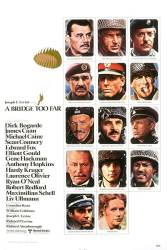Factual error: Most of the parachutes are PX type. These came out in the 1960s. They only used X type during the war - only a few of those are seen in the film. (00:07:00)
Factual error: The shots of an air-strike on German artillery positions during the first armour encounter have used the Harvard aircraft (also known as T-6 Texans). However these were only used as advanced trainers by the Allied forces and never used in combat in the European theatre. One could assume from the theatrical paint jobs that the production team were attempting to disguise them as P47 Thunderbolts.
Factual error: There is a close-up of a parachutist's boot as he leaves the aircraft. It is a DMS boot. DMS boots were not issued to the army until much, much later. Late sixties, early seventies as I recall.
Factual error: The German tanks in the film are Leopard 1 tanks, which were made about 20 years later. Although the turret and the cannon are changed and there are different skirts, the Leopard is very recognizable by it's specific exhaust grill and back. (01:46:40)
Factual error: During the German assault on the bridge, one of the destroyed vehicles on the bridge is actually a French Hotchkiss-Brandt CC-2-55. Although it is disguised as a German Marder III tank destroyer, its lower chassis is still easily recognisable as the CC-2-55.
Factual error: In the first shot of the scene when the 30 Corps lines up on the roadside while Fox yells at his men, two of the Sherman tanks can been seen with objects which look like tires beneath their chassis. These two tanks are likely to be mock-ups built on wheeled vehicles. (00:43:30)
Factual error: The tanks overlooking the river are actually French AMX-105 self-propelled artillery introduced in 1955. (02:01:00)
Factual error: The Waffen SS soldiers throughout the movie are wearing the wrong uniforms. By 1944, most Waffen SS soldiers should be wearing half or full camouflage. Their helmets also shouldn't have the swastika on it, and many should also have been camouflaged.
Factual error: One of the tanks in the column is an M47 Patton which was first introduced in 1951. (01:01:20)
Factual error: When the tank corps is shown before leaving, the village is refered to as Leopoldsville. It was in fact the Belgian village of Leopoldsburg. It's shown on the map as Bourg Leopold (which is the correct French name). Leopoldville was the capital of the Belgian Congo which is now called Kinshasa.
Factual error: During the 9th SS Hohenstaufen assault on the bridge, SS-Hauptsturmführer Grabner's vehicle is actually a British Bren Gun Carrier modified to look like an Sd.Kfz.251. (01:23:10)
Factual error: In many of the scenes, German Mauser rifles do not have cleaning rods. However, judging from archive footage, almost all Mauser rifles used by the Germans during World War II had cleaning rods attached. Many weapons dealers sell World War II surplus rifles without cleaning rods because they are welded into the barrel as part of the deactivation process, hence why they're missing. Still a mistake though.
Factual error: The C-47s are shown with steel collapsible chocks that were in use in the RAF from about 1960 onwards. In WWII all chocks were made of wood.
Factual error: In the conference between Feldmarshalls Rundstedt and Model, they decide to move the 2nd SS Panzer Division, under Bittrich, to Arnhem to refit before fighting Patton's anticipated attack. Actually, it was Bittrich's II SS Panzer Korps (with the 9th and 10th SS Panzer Divisions) that were at Arnhem. The 2nd SS Panzer Division did not fight at Arnhem.
Factual error: When the British and American soldiers are pushing the Bailey Bridge, you can see a British soldier in the background carrying a modern white and red megaphone. (01:44:28)
Factual error: The shot of a tank wreck being pushed off the road following the first tank battle shows a Chaffee light tank, which was only used by the Americans and not the British. Anyway, it was first used in Europe in November 1944 after Operation Market Garden took place.
Factual error: During the 9th SS Hohenstaufen assault on the bridge, the lead vehicle (the one that gets destroyed first) is a four-wheeled vehicle disguised as an Sd.Kfz .221 armoured car but not the actual vehicle. (01:22:45)
Factual error: As they storm the bridge there is a row of modern sodium street lights prominently visible that didn't arrive until the 70s.






Suggested correction: Expecting 1970's paratroopers to wear 1940's boots is hardly an error. There were no 1944 issued boots for the 200 odd para's to wear! Anyway I used to jump with non issued Corcoran jump boots instead of issued Army boots.
stiiggy
An attempt to correct this was already made. In this type of film, it is a very valid mistake, just as if cars from the 60's or 70's were seen in the film. Even if the viewer doesn't expect characters not to wear era appropriate attire, it still a mistake, which is the point of this whole website.
Bishop73